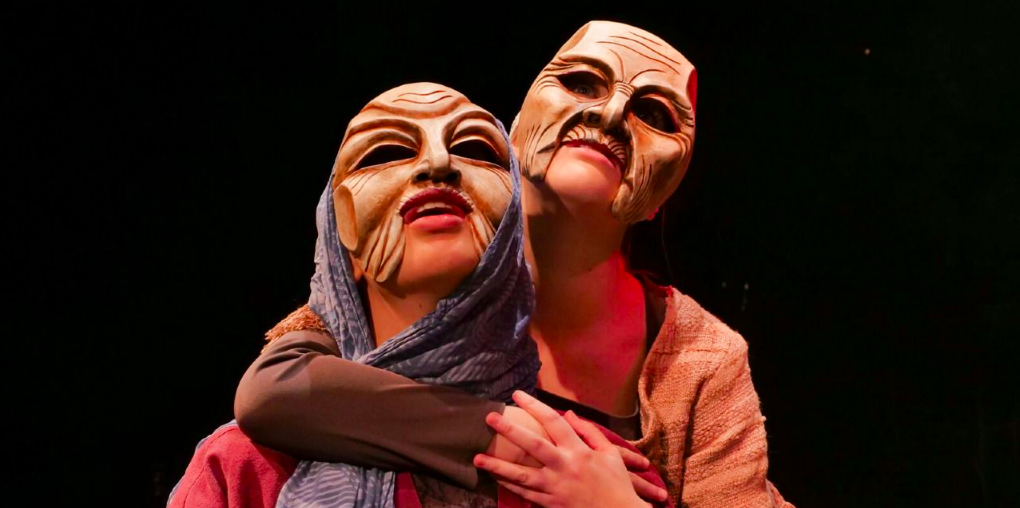
Hecuba (CU Theatre & Dance Department/cupresents.org)
The world debut of Diane Rayor’s translation of Hecuba proves to be an elegant display of agony and retribution through the powerful voices and exquisite movements of the CU Theatre and Dance Department.
Hecuba is the story of a mother’s unbearable tragedy and loss, a woman of ultimate power brought down to the depths of slavery while enduring the murder of her children. “Hecuba is an examination of the psychology of the powerful and the powerless in time of conflict,” the director’s notes said. “Hecuba’s world, not so unlike today, is unstable and characterized by sudden changes and violence.”
The Greek tragedy was written by Euripides circa 424 BCE, taking place after the fall of Troy while the Greeks still occupied the city. Hecuba, once queen of the fallen city, lost her husband and many children throughout the Trojan War. It is the loss of her daughter, Polyxena, and son, Polydorous, that finally drives her to the edge — the catalyst of her transformation from victim to vindicator.
Hecuba’s arc isn’t an easy one to view, but the individual feelings taken away from the performance reflect on the emotions and process we as individuals go through when faced with trauma.
As Hecuba seeks revenge, her murderous streak begins to seem just. Despite the cruel killing of innocents, it isn’t difficult to sit back, watch and even side with her and the decisions she makes as the play goes on. Hecuba is a very bleak, disheartening experience, yet it is a tremendous and significantly dramatized depiction of what it feels like to be wronged.
Elena Sayeedi portrays Hecuba magnificently, donning a still mask and blacked out eyes. She uses her exposed mouth and hands to create narrative body language that could almost eliminate the need for words. Aziza Gharib, Ashley Munson and Sean Guderian are just a few of the supporting actors that help construct the framework for Hecuba’s tragedy. Alongside Sayeedi, Gharib notably has one of the most powerful voices of the performance and can eloquently carry her voice from shaking wails to flowing harmonies.
The chorus surrounds Hecuba with a concerned and caring tone, always laying a hand on one another as they create the atmosphere of the show. The masks of the chorus are the most interpretable. With worried looks transforming to vengefulness, the Trojan women of the chorus echo the emotions of the constantly crying Hecuba.
Jonathan Becker, a Roe Green Artist, created original masks for each of the characters in the show. The masks cover all but the mouth of each cast member. With body language and the tones of the moment, the mask could seem worried, sad, afraid or vengeful, despite being molded still to the actors faces.
The CU Theater and Dance Department’s adaptation of the play incorporates original art and music that adds elegant details to this already admirable drama. The set was rather simple but thoughtfully put together, with hanging sheets able to represent many settings from the ocean to a tent. Although the use of props were minimal and the costumes were practically rags, the scene felt full and extravagant due to the mesmerizing movements and voices.
Jesse Manno, music director of the CU Dance Program, created original music for the CU performance of Hecuba. Using a lute and recorder among other various instruments, Manno and Egemen Kesikli establish a melancholic, tranquil ambience for the production. The score is subtle, yet flows through the tone of the show, emerging as situations tense. Some moments call for silence, but the transitions back into the music are delicate and rather alluring.
CUs Performing Arts’ Hecuba is performed November 2-11 with upcoming performances Friday, Nov. 9 and Saturday, Nov. 10 at 7:30p.m., and Sunday Nov. 11 at 2p.m. Hecuba will be portrayed by Elena Sayeedi on Friday and Sunday and by Katie Lennon on Saturday.
Contact CU Independent Arts Writer Alyssa Branch at Alyssa.Branch@colorado.edu.
